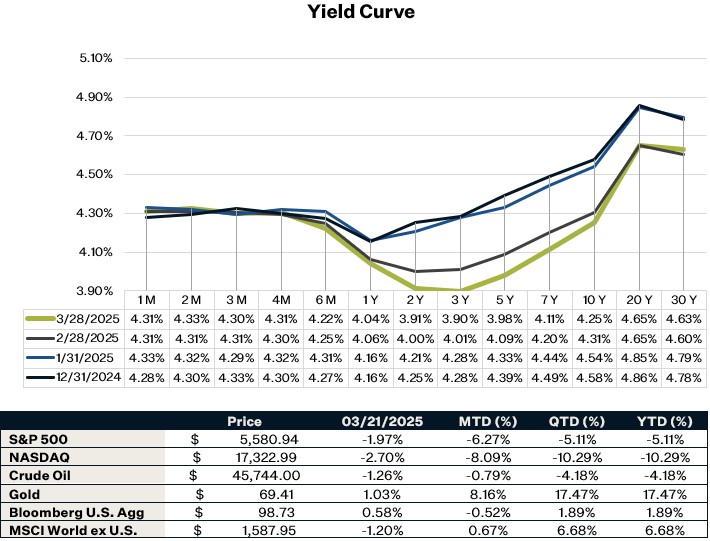
Market Update
More announcements on the tariff front last week continued to rattle markets, as well as data that showed slightly higher inflation than expected. On Wednesday, President Trump announced a 25% tariffs on all imported autos and certain auto parts. This intensified fears that broader tariffs are coming, which could possibly dampen growth expectations even more. Looking at the data, the U.S. market finds itself at a crossroads, caught between diverging signals from soft and hard data. Soft data, primarily survey-based measures, is reflecting growing consumer unease amid heightened uncertainty around tariffs. Consumer sentiment fell to a two-year low of 57, with inflation expectations over the next 12 months climbing to 5%. In contrast, hard data paints a picture of an economy that remains relatively healthy. The labor market continues to add jobs, albeit at a more moderate pace, and GDP growth for Q4 2024 came in at a solid 2.4% annualized rate. The central question now is whether the deterioration in soft data will begin to filter into the hard data. Friday’s Personal Consumption Expenditures (PCE) report hinted at that possibility, with inflation-adjusted consumer spending rising just 0.1%, weaker than expected. As previously noted, much of the recent soft data weakness stems from uncertainty surrounding trade policy. This week we’ll get several updates on the labor market –most notably the NFP payroll report on Friday. We’ll also get more details on the additional tariffs Trump is expected to impose on April 2nd. Market expectations are that the tariffs will be limited, however they could end up being higher and more extensive than expected, which could result in further volatility.
Personal Consumption Expenditure (PCE) inflation
Consumer spending came in below expectations for a second straight month in February, while inflation picked up. The Fed’s preferred inflation gauge, core PCE, rose 0.4% from January and 2.8% year-over-year, remaining well above the central bank’s 2% target. Inflation-adjusted spending rose just 0.1%, with a rare decline in services spending, the first in three years, highlighting growing price sensitivity among consumers. Goods inflation showed its largest two-month gain since 2022, driven partly by consumers buying ahead of expected price hikes. The data suggest households are feeling the squeeze: real disposable income rose just 0.1%, savings ticked up to a nine-month high at 4.7%, and sentiment surveys show rising anxiety. Spending on goods like cars rose, but services, a core driver of the economy, saw cutbacks in categories like dining, rideshares, and vet care.
Q4 GDP
The U.S. economy expanded at a faster pace than previously estimated in the fourth quarter, with GDP growing at a 2.4% annualized rate, driven by upward revisions to net exports, government spending, and business investment. However, the outlook for 2025 has dimmed as economists now project full-year GDP growth to slow to 2.0%, down from 2.3% in last month’s forecast. The downgrade reflects growing concerns about weakening consumer spending, fading business investment, and the disruptive effects of trade policy uncertainty. The first quarter of 2025 is expected to show a sharp deceleration, with GDP growth marked down to 1.2%, largely due to a surge in imports as businesses front-load purchases ahead of upcoming tariffs. While the economy showed solid momentum at the end of 2024, the combination of softening demand, elevated inflation, and policy-driven headwinds suggests slower growth ahead.
Services and Manufacturing Activity
The flash Services PMI for March showed a partial rebound in services activity, which the index rising to 54.3 from 51 in February. Activity remains slightly subdued however as 2025 levels are the lowest readings since April of last year. However this month’s improvement calms fears that a sharp slowdown is occurring. Services firms remain cautious about future demand though, with expectations for future services activity falling again in March.
Unlike the services index, the flash PMI for manufacturing fell in March. This is consistent with other recent measures showing a drop in manufacturing activity as well. Both output and new orders declined. Looking at the reports, what’s particularly concerning is the price pressures that both services and manufacturing businesses are experiencing. Prices for manufacturing reached their highest level in 2 and a half years, and prices for services reached an 18-month high. The report attributed tariffs and increased labor costs as reasons for the increase in input costs.
Sources:
https://www.bea.gov/data/income-saving/personal-saving-rate
https://www.bea.gov/data/gdp/gross-domestic-product
https://www.pmi.spglobal.com/Public/Home/PressRelease/a30301f1804041a083e1a0671ee3df46


